Vertigo ranges from somewhat common to very common, with the National Institute of Health estimating 20% to 56% of the population experiencing vertigo each year.
Vertigo is a sensation of spinning dizziness, the kind that feels as if the room and/or your surroundings are swirling around you. It is common in the elderly and in pregnant people. It is common to experience vertigo when looking down from a tall height and when getting up out of bed in the morning.
In my practice, when I have patients lay on their back so that I can examine their leg lengths for a misalignment of the C1 vertebra, sufferers of vertigo have trouble in this position, as well as when looking up while in a seated position. More on this in a moment.
Surprisingly, vertigo is considered more of a symptom than a condition. With that being said, this debilitating “symptom” has its own set of sub-symptoms, if you will. They are: trouble with balance; lightheadedness; motion sickness; nausea and/or vomiting; tinnitus (ringing in the ear); a feeling of fullness in the ear, as if a blockage or a buildup of fluid; headaches; and nystagmus (eyes involuntarily move side to side).
Conditions in which vertigo is a symptom include the following:
Labyrinthitis – inflammation of the inner ear due to an infection. Directly affects the vestibulocochlear nerve (cranial nerve VIII), which sends signals to the brain about head movement, body positioning, and sound. Tinnitus, hearing loss, pain, headaches, and changes in vision are also possible.
Vestibular neuritis – inflammation of the vestibular nerve (a branch of cranial nerve VIII) caused by an infection. Similar to labyrinthitis, but without the hearing loss.
Cholesteatoma – skin growth in the inner ear behind the ear drum caused by repeated ear infections. Can damage the bones of the middle ear.
Ménière’s disease – A disease in which the inner ear experiences dysfunction. It is characterized by the triad of vertigo, tinnitus, and hearing loss, and is most common between the ages of 40 and 60.
Benign paroxysmal positional vertigo (BPPV) – Inside our inner ear are the saccule and utricle, also known as the otolith organs. Inside these organs are crystals of calcium carbonate. When they break free of the otolith organs, they make their way into a network of fluid and microscopic hair-filled tubes called the semicircular canal. This is a problem because the semicircular canal sends signals to the brain about head positioning. Remember above when I said it is common to see people experience vertigo when I have them lay on their back? This is the vertigo people are experiencing in those instances.
Many other conditions like migraine headaches, concussions, strokes, and stress can also trigger vertigo.
How chiropractic relates to vertigo
One condition in which vertigo is a symptom not mentioned above would be a misalignment of the C1 vertebrae, also known as the atlas. This is not a commonly known condition outside of the chiropractic world, and that is truly a shame because it can be so devastating. With nearly every nerve in the body passing through the C1 vertebra, a misalignment here will cause some sort of issue somewhere in your body.
In my experience as a chiropractor, vertigo has almost always been a symptom of a C1 misalignment, and it could be from a couple different reasons.

Mechanoreceptor dysfunction – The upper cervical spine has the highest percentage of mechanoreceptors of anywhere in the entire body.
In Basic Neuroscience (2nd edition, WB Saunders, 1991), physiologist Arthur Guyton explained that the proprioceptors (sensory receptors responsible for sensing body positioning) most responsible for our sense of equilibrium are the mechanoreceptors of the cervical spine.
Fluid build-up in semicircular canals from a weakened immune system – Be it from congestion or repeated ear infections, fluid buildup in the middle ear can make its way into the inner ear, more specifically the semicircular canal, and can result in serious vertigo. When a subluxation is removed, proper communication between the nervous system and body is restored.
Considering the nervous system controls all other systems in the body, including the immune system, draining of the inner ear and the resulting alleviation of vertigo symptoms are very common after proper C1 positioning has been restored.
Vertigo does not have to control your life. If you do suffer from vertigo, a specific chiropractic adjustment may just be the thing needed to restore some quality to your life.












